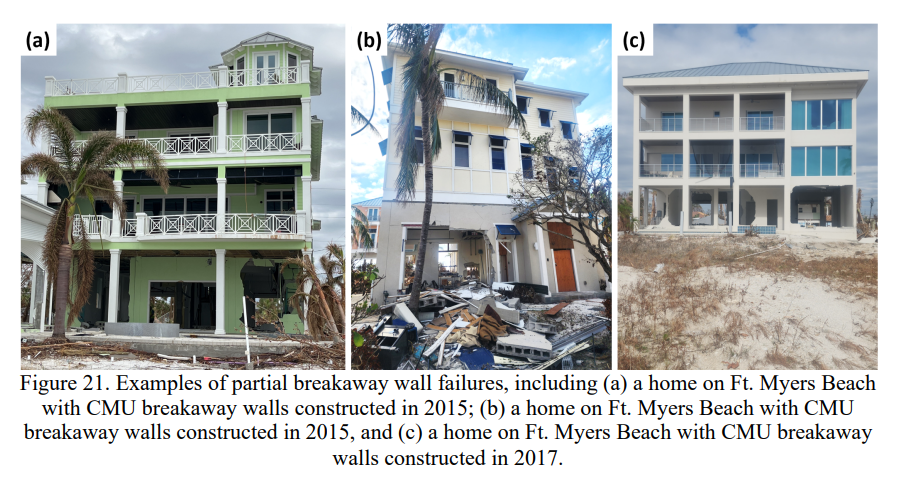Vegetation seemingly helped counter storm surge
 A final report on Hurricane Ian submitted to the Florida Building Commission contains conclusions and recommendations that provide new insight on the Category 5 storm’s damage and what changes may be needed to the current 2020 Florida Residential Building Code (FRBC).
A final report on Hurricane Ian submitted to the Florida Building Commission contains conclusions and recommendations that provide new insight on the Category 5 storm’s damage and what changes may be needed to the current 2020 Florida Residential Building Code (FRBC).
Hurricane Ian made landfall last September in Lee County and was the third-costliest storm in US history ($112.9 billion), the costliest in Florida history ($109.5 billion), and the deadliest in Florida since the 1935 Labor Day hurricane. In all, 156 Florida deaths are attributed to Ian, with 66 direct deaths, nearly 50% of them over the age of 70 according to the final report, prepared by Dr. David O. Prevatt of the University of Florida and a team of structural engineers.
Although Ian’s wind speed on land of about 120 mph was below the building code standards of 154-160 mph for Lee County, Southwest Florida coastal communities were “ill-prepared” for the “catastrophic” storm surge and flooding. The report concluded:
- Residential buildings constructed to the 2002 Florida Building Code or later suffered minimal observable, structural damage from either wind or surge hazards;
- Breakaway walls observed in the study dataset mostly performed as intended;
- There was no evidence found that structures built to the Florida Building Code seaward of the Coastal Construction Control Line (CCCL) performed worse than those located inland of the CCCL;
- Structures on Sanibel were less likely to experience severe surge-induced damage relative to those on Fort Myers Beach, despite similar high-water mark elevations, due potentially to Sanibel’s higher vegetation coverage;
- Roof cover systems of all kinds installed within the last 5 years performed well under Hurricane Ian’s winds, but their vulnerability increases with age;
- Wall cladding systems generally had less damage than roof cover but was still observed in 13% of the structures, with nearly twice the frequency in pre-FRBC homes relative to post-FRBC homes; and
- Rooftop solar panel systems and sunrooms were frequently damaged by wind despite the relatively low wind speeds with respect to design levels.
 “The severe damage we saw was really the flooding, in particular the manufactured homes on Fort Myers Beach and mostly older slab-on-grade homes,” said Dr. Prevatt, on our recent Florida Insurance Roundup podcast that followed the release of his team’s interim report in April. “The good news, if there is any that we can draw from this, is that recent construction built to the recent Florida Building Code standards performed well, even in areas where they were impacted by the 13-foot high storm surge.”
“The severe damage we saw was really the flooding, in particular the manufactured homes on Fort Myers Beach and mostly older slab-on-grade homes,” said Dr. Prevatt, on our recent Florida Insurance Roundup podcast that followed the release of his team’s interim report in April. “The good news, if there is any that we can draw from this, is that recent construction built to the recent Florida Building Code standards performed well, even in areas where they were impacted by the 13-foot high storm surge.”
 “Even on the wind side, some of these inland counties saw a significant amount of claims, primarily coming in from roof damage,” added Dr. Karthik Ramanathan, Vice President of Research at Verisk, who was also on the podcast and produced early catastrophic models on Ian for insurance companies. “And to me, it’s mind boggling, seeing the same state which sort of pioneered wind design, not just in the United States, but across the world, is seeing some of the same issues 30 years on in an event like Ian.”
“Even on the wind side, some of these inland counties saw a significant amount of claims, primarily coming in from roof damage,” added Dr. Karthik Ramanathan, Vice President of Research at Verisk, who was also on the podcast and produced early catastrophic models on Ian for insurance companies. “And to me, it’s mind boggling, seeing the same state which sort of pioneered wind design, not just in the United States, but across the world, is seeing some of the same issues 30 years on in an event like Ian.”
The report recommended further study be done on the performance of structures with respect to wind-driven rain, rainwater ingress, and interior damage due to storm surge, which this report didn’t evaluate. It also suggests further study on secondary water barriers, which it noted failed on several roofs. This report is chock full of new images and data helpful to engineers and mitigation, construction, and insurance interests.
You can listen to and read more about my full conversation with Dr. Prevatt and Dr. Ramanathan of Verisk, here.
LMA Newsletter of 6-26-23

